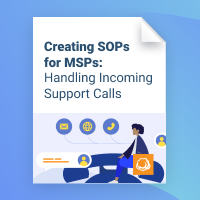Today, most workloads are remote and most users are trained and understand what they are doing. Hence, there are far fewer tickets from clients. That means that managed IT professionals have a bit more free time than they are used to having. That is the ideal moment to review internal processes and documentation. It might turn out that some of them need fine-tuning or a complete overhaul.
In this article, we will define three key areas to begin with.
Review Your Tickets
Your MSP tickets are a source of knowledge about your customers and your team. Here are several insights that you can get by reviewing them:
1. Overdue tickets and response times. Does your team answer in good time? If not, which cases are overdue and are there any common issues? All that information can help you to determine where and how you can enhance your support for the clients. For example, receiving many similar tickets from one given client could tell you that either they are not trained enough in a particular area or their solution needs rethinking.
2. Most frequent questions. One option is to create canned responses, so your support team can provide faster answers to questions like, ”How do I use single sign-on in Office 365?”. Another is to improve your FAQ section and update your customers about it. Finally, try to understand why these questions emerge so often. As in the previous example, the most frequent questions can show you where there is room for improvement.
3. The quality of your answers. Do your support staff talk to your clients in an understandable and polite manner? Do they follow your guidelines and workflows? If not, it’s probably your fault because you haven't created enough guidelines for them, or haven't enforced them.

Automate
Many MSPs know that automation is the key to efficient business processes. However, not every managed IT professional finds enough time in their typical daily routine to develop process automation - writing and checking scripts and implementing them. That eats up a lot of time and might always be postponed “till next week”.
Now, when the ticket load is not as big as before the pandemic, you might have more time to develop profound automated processes, test, and implement them. Here are a couple of ideas on how to do that:
1. Automate routine processes. Find out which processes are eating up your and your staff’s time and automate them if possible. It could be everything from Office 365 account setups to installing fresh machines.
2. Review your existing scripts. Are they well written and could they be enhanced? Also, it would be a good idea to add descriptive comments to your scripts if they are liable to be used by anyone from your team.
3. Work with your team. Your team is a source of knowledge. They can tell you which exact area can be enhanced and they can help you in the development of your scripts. You should teach them how to use newly added automated processes and create a clear workflow for them.
Further reading 5 Tips for MSPs: Automated Cloud Backup and Other Ways to Save Time
Review Your Educational Processes and Documentation
There are two equally important educational and onboarding processes that you should care about: those that apply to your employees and those created for your customers. They differ a lot, but their core processes are similar. These activities should be streamlined, understandable, and reachable by the end user.
1. Your customer-facing documentation, as a rule, should not be technical. Even when you explain technical concepts, be as descriptive as possible. Remember, your customers do not care and do not want to know about technicalities; they need IT solutions to boost their business, not to overload their minds. So, try reviewing your customer documentation with a friend of yours or a relative who is not much of a technician.
2. Check your customer-facing documentation delivery methods. Do your customers understand where to find your FAQs and training sessions? Whether you are sending documents like spreadsheets, or you have created an internal wiki database, or you are using a specialized documentation solution, all these methods can be reviewed and enhanced. Alternatively, you might want to find a solution that would be a better fit for the needs of your clients.
3. Do you have onboarding procedures for your new employees? A well thought-out documentation and onboarding process allows your new staff to be more effective right from the beginning. The processes may include the supervision of all newcomers and weekly reviews of the work done.
Are your educational materials out of date? You may have changed your solutions stack or updated your policies, but postponed adding these changes to internal and customer-facing documentation.
Further reading How to Create MSP Documentation: Baseline Principles
Conclusion
The current pandemic is a real-life, severe crisis. However, when it eventually ends, your workload will be as high as, or even higher than, before. You will have to help your customers to readjust their businesses to the new realities, bring some of the workloads back from home, and create a new, hybrid office/home environment for them. So, while you still have some free time, sit down and work on the improvement of each process and documentary component of your managed IT business. In the end, that will help you to achieve better results and become a better MSP for your clients.





